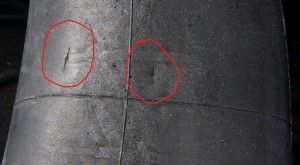 A flat tire is something that practically every cyclist has to deal with at some point or another, but many novices may be unaware that there are actually a number of different ways that you can get a puncture, each of which requires a slightly different method to deal with or prevent.
A flat tire is something that practically every cyclist has to deal with at some point or another, but many novices may be unaware that there are actually a number of different ways that you can get a puncture, each of which requires a slightly different method to deal with or prevent.
Pinch flats, which are known as Snakebites in some corners of the cycling world, are perhaps the most irritating of all flat tires because they can cause damage that a puncture repair kit will struggle to fix and often result from fairly innocuous riding. As such, it is possible to get a pinch flat if you are a road cyclist, meaning that even ensuring your route is as flat as possible isn’t always going to help you. As such, you need to take the proper precautions with your route before you ride.
What Is A Pinch Flat?
 A pinch flat most commonly occurs when you run over something with your bike that causes the inner tube to punch against the wheel rim, resulting in a flat tire. In the worst case scenarios they will require you to replace the inner tube and, in some cases, may even lead to dents forming in the rim itself. However, in many cases, you should find that the tire itself is unaffected.
A pinch flat most commonly occurs when you run over something with your bike that causes the inner tube to punch against the wheel rim, resulting in a flat tire. In the worst case scenarios they will require you to replace the inner tube and, in some cases, may even lead to dents forming in the rim itself. However, in many cases, you should find that the tire itself is unaffected.
This type of flat is distinguishable because of the unique pattern that develops on your inner tube. You will notice two small holes that are side by side when you check the tube, creating a snakebite pattern that gives this type of flat its alternative name.
How Are Pinch Flats Caused
Pinch flats are caused by riding over something with your bike that is big enough to give your wheel a bit of a jolt. For example, stones and manhole covers are both capable of causing a pinch flat.
This is because what you hit isn’t what punctures the inner tube. Instead, it is the pinch between the tube and the rim that causes the damage. That means that any object, whether sharp or blunt, is capable of causing a pinch flat if the jolt to your wheel is big enough.
What To Do When You Get a Pinch Flat
In some cases you will be able to repair a pinch flat using a puncture repair kit, however this can only be done if the kit contains a patch that is big enough to cover both holes. It also doesn’t remedy the issue entirely, so you will probably have to do a little extra work on your bike when you get back.
Even if you have managed to patch the inner tube up, it is still advisable to replace the tube as soon as possible so that you can ensure that the bike continues to ride well and you don’t have to keep bringing puncture repair kits along with you.
How To Prevent Pinch Flats
One way to avoid a pinch flat is to be really careful with your riding so as to ensure you don’t ride over anything that could jolt the wheel. However, this is not always possible, especially if you are pushing yourself to your limits and need to focus on that aspect of the ride.
It is important to note that pinch flats are more common in bikes where the tires have fairly low air pressure. This allows for more room for the inner tube to slip and get caught against the rim, so if you want to give yourself the highest chance of avoiding the issue then it is a good idea to pump up your tires regularly and ensure that they have the proper air pressure. For mountain biking you want to ensure that you have a minimum of 25psi and road biking a minimum of 85psi.
If you continually find you are getting pinch flats, make sure to increase the air pressure in your tires.